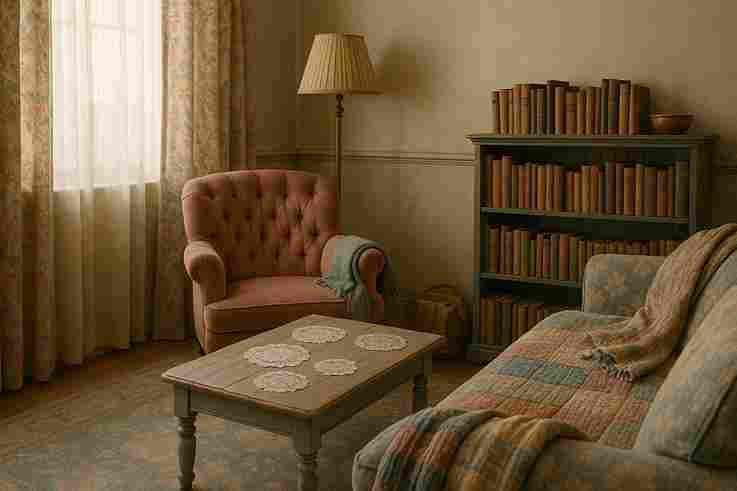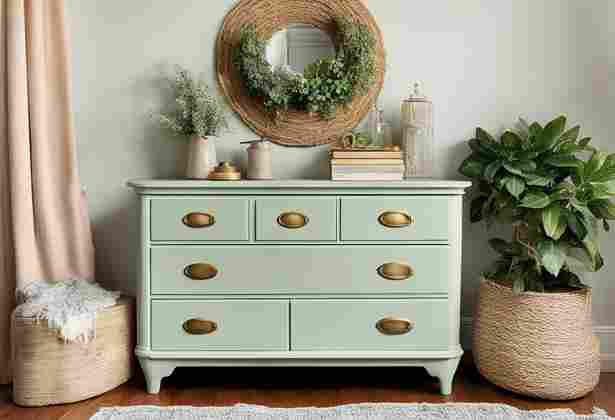Vintage Decor Secrets for a Dreamy Home Look
Vintage Decor is making a strong comeback in American homes. This design style, rooted in charm, individuality, and timeless aesthetics, offers more than just a nostalgic appeal. Vintage decor transforms ordinary spaces into warm, expressive environments that tell a story—often blending history with personal taste.
Its resurgence isn’t surprising. As fast-paced trends fade quickly, more homeowners and renters are seeking meaningful, character-rich interiors. With vintage decor, you don’t just furnish a space—you curate it.
In this blog, we’ll explore what defines vintage decor, room-by-room ideas to inspire a dreamy home look, common mistakes to avoid, and how to incorporate vintage elements without sacrificing functionality. You’ll also find a printable styling guide and expert tips on sourcing authentic, affordable pieces.
What Is Vintage Decor?
Vintage decor refers to interior styling that incorporates pieces from the past—typically between 20 and 100 years old—that reflect the design trends of their time. These items are often secondhand but retain quality craftsmanship, nostalgic charm, and visual character that give a home a curated, lived-in feel.
It’s important to distinguish vintage from related terms:
- Antique usually refers to items 100 years or older, often collected for historical or monetary value.
- Retro imitates styles of the past but is newly made—think diner-style bar stools or reproduction radios.
- Shabby chic is a design trend focused on distressed finishes and soft, romantic tones, but it’s more stylized than authentically vintage.
Vintage decor brings emotional resonance into a home. Each piece often carries a story—whether it’s a handed-down dresser, a market-found rotary phone, or a timeworn lamp with personality. These items evoke comfort, warmth, and authenticity in a way mass-produced decor rarely can.
Blending old with new, vintage decor allows for both self-expression and sustainability—making it an increasingly popular choice for those who want a home that feels soulful, timeless, and uniquely their own.
Key Elements of Vintage Decor for a Dreamy Look
Vintage decor thrives on detail. From furniture to finishes, every piece plays a role in shaping an inviting, timeless space. Below are the core elements that define this enduring style.
Furniture That Feels Lived-In
Vintage furniture often features tufted upholstery, curved silhouettes, and natural wear that speak to its origin and craftsmanship. These pieces are rarely perfect—and that’s their strength. A worn leather armchair with softened edges, a dining table with subtle scuffs, or an iron bed frame with patina all carry visual depth and emotional weight. Look for materials like distressed wood, aged metals, and solid frames that showcase endurance over time. Elements such as carved details, turned legs, or exposed joinery reflect quality design rarely found in mass-produced furniture today.
Rather than matching every piece, vintage decor embraces intentional variety—mixing eras, finishes, and textures to create a space that feels curated rather than styled. Whether it’s a wingback chair inherited from family or a flea-market dresser, these furnishings add character that grounds a room. They don’t just fill space; they add meaning. Each piece contributes to a home that feels both lived-in and loved, delivering comfort, individuality, and an enduring sense of place.
Textiles with Character
Fabrics are essential to achieving a truly dreamy vintage aesthetic. Unlike minimalist or ultra-modern interiors, vintage decor celebrates warmth, tactility, and nostalgia—and textiles play a central role in expressing these qualities. Incorporate floral prints, lace trims, velvet cushions, and patchwork quilts to introduce visual softness and historical texture into your space. These materials aren’t just decorative; they evoke a sense of comfort and tradition that modern fabrics often lack.
Layering is key
A lace table runner over an aged wood surface, velvet pillows resting on a tufted settee, or a stack of hand-stitched quilts at the foot of the bed adds richness and emotional depth. Mixing textiles of different weights and patterns brings movement and personality to any room without overwhelming it. Each piece tells part of a story—whether it’s passed down, found, or repurposed—and together they help create a space that feels intentionally styled, emotionally warm, and uniquely lived-in.
Color Palette: Soft and Faded
Vintage decor favors calming, weathered tones that evoke a sense of serenity and age. These colors are often inspired by natural fading, sun-bleached fabrics, or pigments used in earlier design eras. Rather than bold or saturated hues, vintage interiors lean toward soft whites, muted greens, dusty pinks, and faded blues—each carrying a quiet elegance that complements the worn textures and layered details of the space.
This subdued palette acts as a visual foundation. It doesn’t compete for attention but instead allows the richness of vintage furniture, textiles, and accessories to take center stage. A dusty rose armchair, for example, looks more striking against a backdrop of antique white walls than it would in a modern, high-contrast setting. These gentle tones also help unify a space, especially when mixing pieces from different eras or styles.
Used consistently, these hues promote a cohesive look and a peaceful ambiance. Whether in large-scale applications like painted walls or in smaller accents like curtains, cushions, or ceramics, vintage colors support a sense of timelessness and emotional warmth that defines the style.
Accessories That Tell a Story
Details complete the look in vintage decor, offering the finishing touches that bring authenticity and charm into focus. While furniture and textiles establish the foundation, accessories add nuance, texture, and a sense of narrative. Thoughtfully selected items like porcelain figurines, mantel clocks, brass fixtures, and ornate vintage mirrors contribute layers of visual and emotional interest.
These objects do more than fill empty spaces—they act as anchors of memory and mood. Vintage mirrors, for example, not only reflect light but amplify natural aging with their slightly foxed glass and decorative frames. Brass candleholders or drawer pulls, darkened with age, introduce warm tones that contrast beautifully with faded pastels and worn wood. Even small pieces, like a cracked ceramic vase or an enamel tray, can become quiet focal points that draw the eye.
The beauty of vintage accessories lies in their imperfections—the subtle chips, tarnished surfaces, or uneven finishes that speak to time passed and lives lived. These marks of age lend character and individuality, creating a home that feels both personal and timeless. Often, such pieces invite conversation, curiosity, and nostalgia, transforming a well-decorated room into a meaningful, storied space.
Each of these vintage decor elements helps craft a home that feels soulful, welcoming, and beautifully layered. Together, they build a visual narrative that’s both nostalgic and refreshingly unique.
Vintage Decor for Every Room
Vintage decor can transform any space, whether it’s a sprawling home or a compact apartment. By tailoring key elements to suit each room, you can achieve a cohesive and emotionally resonant aesthetic throughout your living environment.
Vintage Decor for Living Rooms
The living room is often the heart of the home—a gathering space that reflects personality, comfort, and daily life. Vintage decor adds depth and dimension to this central room, balancing form and function with enduring charm.
Curated Furniture as a Foundation
Start with a few statement pieces that anchor the space. A tufted velvet armchair, a distressed wood console, or a mid-century coffee table can immediately introduce vintage character. These items shouldn’t match perfectly—they should feel collected over time. Look for furniture with visible grain, aged patina, or carved detail that reflects craftsmanship. These curated selections form the base of your vintage aesthetic and invite layering.
Layered Textures and Mixed Materials
Layering is key to richness in a vintage living room. Use velvet cushions, lace curtains, woven throws, or embroidered textiles to bring warmth and tactile contrast. Vary materials—combine aged wood, brass accents, leather, and glass surfaces to add complexity and create a well-rounded design.
Avoid rigid coordination. Vintage decor thrives on variety. Mixing different finishes—such as a worn leather ottoman beside a glossy wood side table—adds authenticity. The goal is to feel curated, not staged.
Personal Touches That Tell a Story
Decorate with objects that evoke memory or meaning. Stack old books with worn spines on side tables. Display black-and-white family portraits, candlesticks, or framed botanical prints in aged gold or wood frames. Hang a vintage wall clock, or style a trunk as a coffee table to blend practicality with story.
These elements aren’t just accessories—they are the emotional layer of vintage decor. They make the room feel not only lived-in but also loved and remembered.
Vintage Decor for Bedrooms
A vintage-inspired bedroom should be more than visually appealing—it should feel restful, personal, and emotionally grounding. Vintage decor works beautifully in this space by fostering tranquility, nostalgia, and a sense of timeless charm.
Furniture That Frames the Space
Begin with furniture that sets a calm, curated tone. A wrought-iron bed frame instantly evokes a historical, romantic feel and pairs well with soft bedding. Add carved wooden nightstands or a vanity with curved edges and aged hardware to enhance the mood. These pieces should look well-loved, not perfect—patina, wear, and visible grain add authenticity and warmth.
Avoid cluttering the room with furniture. Instead, select a few anchor pieces that give the space structure while leaving room for personal accents and airiness.
Textiles That Invite Comfort
Textiles are central to a vintage bedroom. Use floral quilts, lace pillow shams, and crocheted throws in soft, muted hues—like faded lavender, antique white, or dusty rose. Mix materials such as cotton, linen, and velvet to create tactile variation and coziness.
Layer bedding thoughtfully. For example, a neutral quilt beneath a floral bedspread with mismatched cushions can evoke an authentic, layered vintage style without overwhelming the senses.
Lighting for Mood and Memory
Soft, ambient lighting reinforces a vintage feel. Choose dimmable table lamps with fabric shades, antique-style wall sconces, or small chandeliers to bring warmth and character. Avoid harsh overhead lights. Instead, aim for glow and shadow that mimic candlelight or lamplight from earlier eras.
Strategically placed lighting also highlights key pieces—such as a framed portrait or detailed headboard—while enhancing overall serenity.
Decor That Speaks to You
This room should be highly personal. Vintage decor shines when it includes items that carry emotional weight. A black-and-white family photograph, a wind-up clock, or a velvet-lined jewelry box tells a story beyond style. These personal accents enhance the room’s emotional warmth and bring quiet joy to daily routines.
Finish the space with a few framed prints, a lace curtain that dances in the light, or a well-worn armchair in the corner. These subtle, soulful touches make a vintage bedroom feel like a retreat that remembers—a place to both rest and reconnect.
Decor for Kitchens and Dining Areas
In kitchens and dining rooms—where function often takes priority—vintage decor introduces charm without sacrificing usability. These are spaces meant for movement, utility, and warmth. A well-executed vintage approach can soften hard surfaces and infuse them with personality.
Open Shelving as a Display Opportunity
Vintage kitchens embrace open storage solutions. Replace upper cabinets or incorporate open shelving to showcase vintage dishware, patterned enamelware, or glass apothecary jars. These elements double as decor and function, allowing you to highlight unique finds without clutter.
Stacking mismatched bowls, arranging glassware by tone, or layering plates by era adds a lived-in authenticity that can’t be replicated with new, uniform sets.
Subtle Hardware Makes a Big Impact
Small upgrades can deliver a big vintage effect. Swap modern drawer pulls or cabinet knobs for brass, ceramic, or aged metal hardware. These changes enhance texture and offer a tactile link to older craftsmanship.
Choose finishes that echo other elements in the room—such as a brass light fixture or wrought-iron pot rack—for a cohesive look that feels intentional, not accidental.
Classic Fixtures and Textiles Add Warmth
Timeless pieces like a farmhouse sink can anchor the space with both style and practicality. Layer in checkered curtains, lace valances, or even embroidered linens to soften visual lines and bring in nostalgic detail. If a full renovation isn’t feasible, consider adding tin signs, milk glass vases, or vintage tin containers for a similar effect.
These accents subtly transform a utilitarian room into one that feels warm, welcoming, and rooted in tradition.
Functional Decor with Vintage Soul
The best vintage kitchens blend style and purpose. Use a stoneware crock for utensils, place wooden spoons in a canister with patina, or display cookbooks in a worn wooden crate. These additions keep the space usable while reinforcing the vintage aesthetic.
In the dining area, consider a weathered farm table, mismatched chairs, or a hutch filled with collected china. A single pendant lamp in aged glass or burnished brass above the table can complete the look, serving as both a design statement and a functional necessity.
Vintage Decor for Small Spaces
Vintage decor works remarkably well in small homes, studios, or apartments. The key lies in functional beauty—selecting compact pieces that maximize space without sacrificing character.
Space-Saving Furniture with Personality
Choose furnishings that are both visually engaging and practically compact. A narrow console table adds presence without bulk. A foldable wooden chair offers charm and flexibility. A vintage trunk can serve as a coffee table, seating, or hidden storage—proving that vintage style doesn’t require sprawling square footage.
Even petite accent pieces, like a carved side table or delicate wall shelf, can introduce historic texture and warmth into a tight space.
Use Walls and Vertical Planes Thoughtfully
When floor space is limited, go vertical. Vintage mirrors can reflect light and visually expand the room. Use floating shelves to display small heirlooms, ceramic jars, or framed botanical prints.
Group items by theme, shape, or color for a clean, curated look. This minimizes clutter while maintaining personality.
Color Restraint and Multi-Functionality
Stick to a limited color palette—soft creams, warm woods, faded greens, or gentle pastels work well. These tones keep the eye calm and create a cohesive feel, even in mixed-material spaces.
Opt for multi-purpose furniture that still holds vintage charm. For example, a drop-leaf table serves both dining and desk purposes. A wall-mounted coat rack with antique hooks becomes a decorative and useful feature.
In small spaces, restraint enhances beauty. Each piece must justify its presence—visually, emotionally, and functionally. Vintage decor allows you to meet this standard with grace, memory, and meaning.
Common Mistakes to Avoid
Vintage decor is captivating, but missteps can disrupt the balance between charm and chaos. Avoid these frequent mistakes to keep your design cohesive and emotionally resonant.
1. Overmixing Styles or Eras
Blending different decades can work—but only with intention. A Victorian chair beside a mid-century modern lamp might clash without a visual thread to connect them. Stick to a cohesive time period or aesthetic mood, and bring in contrast subtly through texture or material, not historical leaps.
2. Crowding Too Many Vintage Pieces
Vintage should feel curated, not crowded. Filling a room with too many antique or retro items can make the space feel heavy or disjointed. Leave negative space to let standout pieces shine. One statement item—like a gilded mirror or clawfoot bench—is often more powerful than five competing pieces.
3. Ignoring Lighting and Proportion
Lighting can either elevate or flatten vintage elements. A poorly lit room may hide intricate woodwork or antique finishes. Use dimmable bulbs, layered fixtures, and vintage-inspired lamps to highlight key details.
Proportion matters just as much. A bulky armoire in a small room overwhelms the eye. Instead, choose appropriately scaled pieces to maintain balance and flow.
4. Avoiding Wear or Patina
One of the greatest charms of vintage decor is its natural patina—scratches, fading, and soft edges tell a story. Over-restoring or seeking only “perfect” pieces can strip the soul from a vintage room. Embrace imperfection as part of authenticity. A little wear adds warmth and texture that new furniture can’t replicate.
By steering clear of these mistakes, you allow vintage decor to speak authentically, creating spaces that are warm, layered, and rooted in time.
Download and start planning your vintage-inspired makeover!
FAQ
Conclusion: Curate a Home That Tells a Story
Vintage decor is more than a style—it’s a way to honor the past while making your space uniquely yours. By thoughtfully choosing aged pieces, layering textures, and blending practicality with personality, you can craft a home that feels soulful, grounded, and visually captivating.
Whether you’re decorating a cozy apartment or a spacious farmhouse, vintage touches bring warmth and narrative to every room. The key lies in balance: respect the charm of timeworn objects while keeping your space livable and uncluttered.
Already using vintage decor? Or just getting started? Share your favorite finds or styling tips in the comments below—let’s inspire each other!

Amina Pierce is a tech-savvy blogger with a specialty in electronics, where she shares practical insights on gadgets, innovations, and the latest trends shaping our digital world. With a strong interest in how technology impacts everyday life, she breaks down complex topics into clear, easy-to-understand articles for readers of all backgrounds. While electronics is her main focus, Amina also enjoys writing on a variety of other subjects, including lifestyle, travel, and personal growth, making her content both diverse and engaging.
Outside of blogging, Amina loves tinkering with new devices, exploring smart home solutions, and capturing her experiences through travel photography. Her blend of technical knowledge and approachable style makes her a trusted source of information and inspiration.


